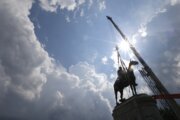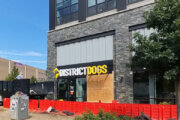MARTIN CRUTSINGER
AP Economics Writer
WASHINGTON (AP) — After a grim start to 2014, the U.S. economy has rebounded with vigor and should show renewed strength into next year.
That was the general view of analysts Wednesday after the government estimated that the economy grew at a fast 4 percent annual rate in the April-June quarter. Consumers, businesses and governments combined to fuel the expansion. The government also said growth was more robust last year than previously estimated.
Whether the healthier expansion will lead the Federal Reserve to raise interest rates sooner than expected is unclear. The Fed offered a mixed message on the economy Wednesday: Growth is strengthening, and the unemployment rate is steadily falling. Yet by some measures, it suggested, the job market remains subpar.
A statement the Fed issued after a two-day policy meeting signaled that it wants to see further improvement before it starts raising its key short-term interest rate. It offered no clearer hint of when it will raise that rate.
Instead, the Fed reiterated its plan to keep short-term rates low “for a considerable time” after ends its monthly bond purchases. The Fed said it will slow the pace of its purchases by another $10 billion to $25 billion a month. The purchases, which have been intended to keep long-term borrowing rates low, are set to end in October. Most economists think a rate increase is about a year away.
The economy sprang back to life last quarter after a dismal winter in which it shrank at a sharp 2.1 percent annual rate. The government upgraded that decline from a previous estimate of a 2.9 percent drop. But it was still the biggest contraction since early 2009 in the depths of the Great Recession.
Last quarter’s bounce-back reinforced analysts’ view that the economy’s momentum is extending into the second half of the year, when they forecast annual growth of around 3 percent.
The government also updated its estimates of growth leading into this year. They show the economy expanded in the second half of 2013 at the fastest pace in a decade and more than previously estimated. The revised data also show that the economy grew faster in 2013 than previously estimated, though more slowly in 2011 and 2012 than earlier thought.
The second quarter’s growth in the gross domestic product — the total output of goods and services — was the fastest since a 4.5 percent increase in July-September quarter of 2013.
Paul Ashworth, chief U.S. economist at Capital Economics, said that given last quarter’s rebound, he’s boosting his estimate for growth this year to 2 percent, up from a previous 1.7 percent forecast. Ashworth said the economy’s growth also supported his view that the Fed will be inclined to start raising rates early next year.
Ashworth is among a group of economists who think growing strength in the job market and the economy will prod the Fed to move faster to raise rates to make sure inflation doesn’t get out of hand. Other economists have been predicting that the Fed would wait until mid-2015 to start raising rates.
The Fed revised the wording of its previous statement to note that while the unemployment rate has dropped steadily, the job market is still struggling in other ways. It didn’t specify what it meant. But Chair Janet Yellen expressed concern to Congress this month about stagnant wage growth, many part-time workers who can’t find full-time jobs and the proportion of the unemployed who have been out of work for more than six months.
The GDP report showed that one measure of inflation rose 2 percent last quarter, up from a 1.3 percent rise in the first quarter. The Fed’s inflation target is 2 percent, and for two years the GDP measure of inflation has been running below that level. Low inflation has given the Fed leeway to focus on boosting growth to fight high unemployment.
In its statement, the Fed noted that inflation had risen closer to its 2 percent target. The statement said concerns that inflation would run persistently below the Fed’s 2 percent target had “diminished somewhat.” But it expressed no worries about the slight acceleration in prices.
The economy’s sudden contraction in the first quarter coincided with a severe winter that disrupted activity across industries and kept consumers away from shopping malls and auto dealerships. Consumer spending slowed to an annual growth rate of 1.2 percent, the weakest in nearly three years.
Last quarter, consumer spending accelerated to a growth rate of 2.5 percent. Spending on durable goods such as autos surged at a 14 percent annual rate, the biggest quarterly gain since 2009. Analysts said that was an encouraging sign of consumers’ growing willingness to buy high-cost items like cars.
“Better job growth, a rising stock market, falling gasoline prices — all those things are starting to resonate on Main Street,” said Stuart Hoffman, chief economist at PNC Financial Services Group.
Hoffman suggested that five straight months of job gains above 200,000 were buoying both consumer and business confidence. He predicted that the July jobs report, to be released Friday, would show job growth of around 225,000. Hoffman foresees growth of around 3 percent over the next year.
The government’s revised estimates going back to 2011 show the economy expanded at an annual rate of 4.5 percent in last year’s third quarter, up from a previous 4.1 percent estimate. The growth rate was 3.5 percent in the fourth quarter, up from an earlier 2.6 percent estimate.
For 2013 as a whole, the government said the economy grew 2.2 percent, up from its earlier 1.9 percent estimate.
Copyright 2014 The Associated Press. All rights reserved. This material may not be published, broadcast, rewritten or redistributed.






